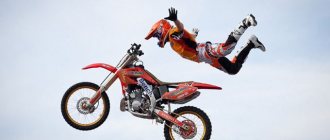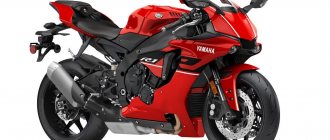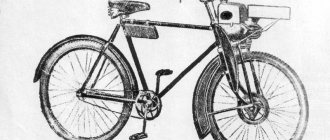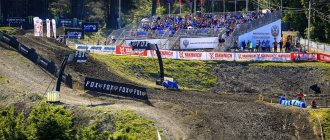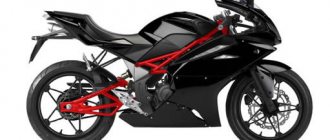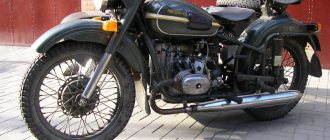Motocross tracks are usually quite long (1.5-3 km) and include natural obstacles with various variations of specially created jumps and other man-made elements. In history, there has never been a track that consisted of hills and turns, without a single jump. Supercross, as a type of motocross, is an entirely man-made track, usually of short length with a large number of jumps and turns, built in stadiums (sometimes indoors).
Due to the size of the track, motocross typically has 40 riders, while supercross has about 25.
Races vary in length, usually measured by time plus 1-2 laps. Grand Prix (GP) or American Champion (Pro AMA) usually takes place within 30 minutes + 2 laps. Amateur races usually take much less, about 10 minutes. When the appointed time arrives, the finish line man signals to the racers that there is one (or two) laps left, and then the race ends with the waving of the checkered flag. Other off-road varieties such as Enduro (almost the same as motocross, only the races take place on a large natural track, and take place much longer and at higher speeds). There a certain number of laps is set or simply a maximum time limit.
Races take place in heats. Usually the race includes two races, the results of which are determined by the final.
general information
Motocross is a type of off-road racing. Competitions are held on specially organized closed tracks 1.5-2 km long, which do not include sections of public roads. They have a natural surface and are necessarily equipped with additional obstacles such as uneven terrain or small jumps. Depending on the scale of the competition, the race is held in 2-3 heats, each of which takes an average of 20-40 minutes + 2 additional laps.
Participants use special equipment and special motocross models of motorcycles, depending on the engine size of which the races are divided into classes. At the same time, existing classes and specific equipment requirements within each of them are indicated for each championship separately.
You can learn more about the design features of a cross-country motorcycle from one of the previous materials.
Physical exercise
Those who don't ride a motocross bike usually don't understand how much physical stress riders go through. For some reason they think that riders do nothing except turn the steering wheel and the throttle, and believe that this is the same as driving a family car.
Motocross requires very serious physical training, mainly in the arms, shoulders and overall endurance. The rider(s) must maintain control of the motorcycle at the highest possible speed while holding a 100kg bike that typically has around 50 horsepower. The rider's arms and legs are constantly in motion while riding, fighting for control and absorbing shocks from small bumps and large jumps, not counting possible undershoots. After all, professional races last more than half an hour. This is a real test for the rider.
The National Institute of Sports and Health in Inglewood, California, tested several professional athletes in the early 1980s. Among them were runners, motocrossers, rugby players, football players, and many others. Tests have shown that motocross riders experience the most stress, and they also have the highest level of physical fitness.
Where did motocross begin?
The very first competition that laid the foundation for motocross is the “Fox Race” in 1908. Not only motorcyclists, but also horse riders took part in it. This set of participants, so strange for a modern viewer, can be explained quite simply: the purpose of the race was to prove that motorcycles can compete on an equal footing with horses in speed and cross-country ability. Despite the fact that the motorcyclists were defeated in this race (11 out of 13 participants did not finish), off-road motorcycle racing continued to exist and develop.
As a result, all this resulted in the emergence of the first official international competition - the European Motocross Championship, held in 1952. In 1957 it was replaced by an even larger World Championship, held under the auspices of the FIM to this day.
In the USSR, cross-country races, despite a fairly strong technical lag behind the West, gained official status already in 1928, when the cross-country race became part of the Spartakiad. The first international competitions took place in 1954. Not only Soviet racers took part in them, but also athletes from Czechoslovakia, Poland and the GDR. And already 2 years later, the Central Automobile Club of the USSR was officially accepted by the FIM, which opened up access to world competitions for domestic motorcyclists.
Why should you take up motocross?
If these arguments seem convincing to you, then you will definitely like these races.
This is a sport
Motocross is not riding a motorcycle, but a real sport that involves constantly improving your skills. The followers of the direction are very strong and agile, and they were not like that from the very first training. Conquering rough terrain with the constant need to control a motorcycle is a real test, those challenges that build character and develop the body. Here you have to work with your whole body and think quickly, make decisions in a split second. It is worth taking up this sport only if you are ready to train regularly, giving your all in every training session.
It's adrenaline
Adrenaline-producing activities are a great way to relieve stress. This is a release of negative energy and a gradual getting rid of fears, pride in having learned to go into a controlled skid and lift the wheels off the ground. The most valuable thing is that over time people learn to control speed and develop their own driving style. Thanks to this, they get as much adrenaline as they need.
This is a year-round hobby
This sport can be a great hobby. It allows you to switch and take a break from everything, maintain excellent shape, become stronger and more confident. Motorcyclists often complain about the short season, this does not apply to motocross, training takes place all year round. In addition, such a hobby is very prestigious; it attracts attention and commands respect.
It's suitable for everyone
Motocross is not just for young guys; it accepts all people, regardless of gender and age. Restrictions apply only to health conditions. This sport teaches girls how to use technology and overcome fears; it helps guys channel their energy in a peaceful direction. If there are no health contraindications, then you can master the basics of the discipline even at the age of 50 years and older. By the way, even children engage in motocross; they train separately from adults.
This is a club of like-minded people
Motocross schools bring together like-minded people, some of whom become true friends. Friendly support allows you to overcome difficulties, achieve a certain professionalism and reach the level of participation in competitions.
Main competitions
Almost from the very beginning of its existence, motocross was the most accessible entry point into the world of professional sports, so there were always enough participants, and a huge number of competitions of various sizes took place. In addition to the World Championship, the main world competitions also include:
- AMA Motocross Championship is an American championship founded by the American Motorcycle Association in 1972. The winners are determined in 3 classes: 450, 250 and Women's MX - a hotel classification for women.
- BritishMotocrossChampionship is the main British championship, held under the auspices of Auto-CycleUnion (ACU) and one of the largest motorcycle tire manufacturers, Maxxis.
- MotocrossdesNations is a team competition that has been held regularly since 1947. Today there are 3 independent races under this name: the original Motocross of Nations (500 class), TrophéedesNations (250 class) and CoupedesNations (125 class).
- The European Championship has existed since 1988 and today is held in 5 classes: EMX250, EMX125, EMX2T (motorcycles with 2-stroke 250 cm3 engines), EMX85, EMX65.
Most major countries that compete internationally also have local races. In Russia it is:
- Russian championship,
- Cup of Russia,
- Russian Cup among women,
- Federal District Championships,
- MFR Cup and others.
A more detailed list of domestic competitions, as well as the current results of past races, can also be found here.
How much does motorsports cost?
Everyone knows that motorsport is an expensive activity. But not everyone understands the degree of high cost.
To estimate the costs of professional motorcycle racing, Motoexpert asked top athletes from the main disciplines to voice their estimates for the competitive season. Since it is unrealistic to estimate the costs of the training process for many reasons, we do not indicate them. Due to currency fluctuations, prices are shown in euros. In this material we will talk about motocross, enduro and supermoto; read about other sports in the next issues of Motoexpert.
Motocross
Alexander Ivanyutin 11-time Russian motocross champion German motocross champion Winner of the XSR-Moto.ru Country Cross Cup
Usually in the summer season I compete in the Russian Motocross Championship, the Extreme Sports Cup in country cross, as well as in separate competitions in these two disciplines.
Since I expect the best possible result, I have to prepare in full. For a season for successful performances, I need at least two motorcycles worth € 7,000, one competition and one training-replacement, which I use in races if the main one breaks down. The main one is equipped with Kayaba suspension, which costs about €5,500, while the spare one is equipped with a standard fork and shock absorber for €500. Two mufflers are replaced for € 1000, small things like footrests, handlebars and levers (€ 500), engines are slightly modified (€ 500). Motocross equipment wears out quickly and gets dirty during a race, so you may need several sets for one day. In total for the season you need four sets of pants/shirts (€ 600), six pairs of gloves (€ 250), six glasses (€ 500), of which three are rewinding, a helmet (€ 500), boots (€ 500), articulated knee pads ( € 1000). The bulk of the races take place in Russia. It costs €500–700 for long trips, and €200–300 for short trips. I live in my camper, in which I transport motorcycles, so I don’t spend money on a hotel, and I eat regular food. The entry fees are also not too large; in total, they spend about € 600 per season. Over the summer, about 30 sets of tires are spent at € 130 each. Ten sets of chain/sprockets are consumed, pads and cables are changed, for a total of € 1,600. Motor oil, lubricants and other chemicals - € 800. Motor engines require “100th” gasoline for a total of € 500. Motocross, Russian championship, five stages. Country cross XSR-Moto.ru Country Cross Cup, five stages. Five traditional and non-calendar races
.
Motorcycles – € 23,000 Equipment – € 3,350 Consumables, fuels and lubricants – € 2,900 Tires – € 3,900 Travel, accommodation, food – € 5,000 Entry fees – € 600 Total: € 38,750 Supermoto
Alexander Latyshev Three-time Russian supermoto champion Two-time Baltic champion Latvian champion Lithuanian champion World Championship participant Master of Sports
I've ridden in supermoto at very different levels of competition with very different budgets. The World Championship involves special expenses, so we won’t take it, we’ll take a budget that allows us to go to first place in the Russian Championship and a more competitive series, the Baltic Championship, where riders from both the former Baltic republics and countries like Finland and Great Britain participate. Training is not included here, this is a separate article, which depends on the level of the rider, the presence of a track nearby, and so on. For the level of national championships such as the Russian or Baltic, it is quite enough either a standard factory supermoto KTM and the like, or a modification of a motocross motorcycle, the suspension of which is redesigned, wheels and brakes are changed. In both cases, the budget for building a competitive motorcycle is approximately €12,000. For the motorcycle, you buy heating pads for €500, spare wheels, on which rain or training tires are put on, so that if necessary, you can quickly change shoes without having to deal with tire fitting. Consumables and fuels and lubricants such as oils, chains, brake pads, gasoline for a motorcycle and so on cost € 1,700. Equipment includes boots (€ 600), helmet (€ 600), leather overalls (€ 1,000), glasses (€ 100) , gloves (€ 100). Travel costs can vary greatly. In Russia, if you average it out, it takes about € 500 for a stage in another city, and this does not include accommodation and the purchase/rental of a car for transportation, since I already have my own car with a special large trailer in which I not only transport the motorcycle, but and I live.
A trip to the Baltics costs € 1000. An athlete’s nutrition during competitions must be of high quality and include, in addition to traditional food, vitamins and similar supplements.
Entry fees for Russian competitions are € 66, for the Baltic ones it is much less, € 20. Finally, a very sensitive expense item is tires. The two-day stage with practice, qualifying and two races costs four sets of € 350 each. The Russian Championship is usually held on one day, so it can be done in two sets. Supermoto
Russian Championship, seven stages, Baltic Championship, three stages Motorcycle – € 12,000 Equipment – € 2,400 Consumables, fuels and lubricants – € 2,000 Tires – € 9,100 Travel, accommodation, food – € 8,500 Entry fees – € 520 —
Total
:
€ 34,520 Enduro
Alexander Luzhin Champion of Russia in enduro Two-time winner of the XSR-Moto.ru Cup in country cross Regular participant in international competitions in enduro and hard enduro Master of Sports
Recently I have been focusing on enduro competitions, with a particular preference for a particularly tough variety, hard enduro. The Russian Enduro Championship usually consists of three stages - one in the Moscow region, two in the regions. On average, going to a stage costs €200–500. This includes travel in your own car, hotel, food and entry fee. At each stage, ideally, install a new set of tires; this costs approximately 8,000–10,000 rubles. If the race was muddy, you will have to replace consumables, pads, chain, and sprockets. This is another € 300. For Russian competitions it is not necessary to use an enduro motorcycle; a standard motocross bike with a minimum number of modifications is quite suitable. So if you have your own motorcycle and transport for transportation, it is quite possible to fit into a budget of € 2000–3000 for the season.
In hard enduro everything is much more expensive.
Almost all races take place abroad, so transporting a motorcycle or renting one locally costs a fair amount. Before the start of the season, you definitely need a new motorcycle, which must be seriously equipped with all kinds of protection and useful tuning. All together it costs €15,000. Each stage is quite different in terms of the travel budget and what you need to take with you. For example, the most budget competition in the Red Bull Hardenduro series is the 111 Megawatt. The race takes place in Poland at the beginning of September, and all the action is packed into a weekend. The trip cost me only €500. And a trip to Romania, to a very difficult multi-day Red Bull Romaniacs race, in my car with my motorcycle cost €3000. Enduro
.
Russian Championship, three stages. International racing series Red Bull Hard Enduro, three stages Motorcycle – € 13,000 Equipment – € 2,000 Consumables, fuels and lubricants – € 2,000 Tires – € 1,200 Travel, accommodation, food – € 4,000 Entry fees – € 2,500 — Total: € 24,700
Sitting turns for “ dummies" >
Similar materials
How much does motorsports cost? Part 2
7 July 2015 21:28 Nikolay Bogomolov
Types of motocross racing
Over the century of its existence, motocross has managed not only to form into a “classical” discipline, but also to become the basis for the emergence of a whole series of varieties of motocross racing, some of which were even eventually officially recognized as separate sports.
- Supercross (stadium cross) - While "classic" motocross tracks are laid out in open areas, supercross is always held in large stadiums. The first such race was organized in 1972. Due to the smaller scale of the event itself, the length of the route and the number of participants were significantly reduced. The length of the “circle” is at least 400 and 300 m in open and indoor stadiums, respectively. The total number of participants is about 25 versus 40 in motocross; more athletes will be uncomfortable and unsafe on the track. Check-in time is also reduced and depends on the class of participants. On average it is 10-30 minutes with 1 or 2 additional laps.
- Arenacross is a complete analogue of stadium cross, but held in even more compact arenas. Typically, such competitions are organized in small cities where it is not possible to hold a “full” race. The first arenacross competitions were held only in 2006, but now they are quite popular in America and are even used as an opportunity for amateurs to join the ranks of professional athletes.
- Motocross on motorcycles with a sidecar is another analogue of classic motocross, in which teams of 2 people take part - a driver and a sidecar rider. The main function of the latter is to prevent the machine from tipping over when passing obstacles and turns by moving its own weight. The first mention of this sport dates back to the 1930s, but now it is official: the World Championship has been held under the auspices of the FIM since 1980. In Russia, competitions are officially accepted in 2 classes: 500 and 750.
- Motocross on ATVs is a competition on motocross tracks held on ATVs according to the rules of motocross.
- Motocross on snowmobiles is a “winter version” of motocross on ATVs.
- Pit bike (mini-motocross) – motocross races on compact motorcycles (pit bikes) built on the basis of 4-stroke 50 cm3 engines. At the moment, pit bike is not included in the All-Russian Register of Sports (VRVS), that is, it is not officially considered a sports discipline in Russia. At the same time, the American Motorcycle Association has already included mini-motocross in its registry.
A little history
To begin with, it is worth focusing on why it is necessary to divide competitions into classes in motocross. It is based on the motorcycle used, or more precisely, its parameters.
Initially, standard road motorcycles were used for competitions, but with the development of sports and the automotive industry, it became clear that this solution was far from optimal.
Firstly, due to the fact that the route was guaranteed to include obstacles, the load on the motorcycle inevitably increased, which led to constant breakdowns. In particular, the exhaust pipe suffered the most, inevitably receiving damage when overcoming jumps, as well as mirrors and headlights - the most fragile components that suffer when athletes fall.
Secondly, the overall weight of the structure began to play a big role - the smaller it was, the more useful power could be obtained from the engine, and the easier it was for the rider to control the motorcycle. In this regard, it was decided to discard parts that were useless in this case. These include the entire electrical part and the most fragile structural elements.
The most important design change was the installation of special motor models, during the design of which they tried to achieve two goals:
- make the motor lighter, since its effect on the overall weight was the strongest,
- bring torque to the forefront rather than top speed, as drivers needed more confident performance of the cars on difficult sections.
So, a fairly impressive number of models began to come out of the assembly lines of manufacturers producing serial motocross motorcycles, differing in the installed engine and, as a result, power. And since motocross has long been considered an official sport, it was necessary to strictly delimit their use in order to achieve maximum fairness of competitions and equality of athletes.
Correct technique
There are two components to a race: the start and everything else. A lot depends on the starting technique, in particular the chances of seeing a checkered flag at the finish.
Start
It all starts with getting your body into the right position. Motorcyclists can often be seen in a forward position at the start, as they prepare for the possible separation of the front wheel. They then lean back in the process as they need to achieve stable traction from the rear wheel to the surface. You can hang your legs so that the pegs remain behind them, and transfer your weight back, then the start will be confident, you will be able to make the rear end easier for slipping.
The second most important point is the use of gas. At the start, you need to open the throttle enough to cross the starting gate quickly, about halfway through to quarter. All this is brought to automaticity through long and persistent training; the skill does not come on its own.
When accelerating and braking
To maintain balance, you need to lean forward when accelerating, and when braking, lean back. Braking is mostly smooth. You should not use the brakes aggressively; such techniques are effective, but too dangerous. When shifting into gear or using the rear brake, you should place your feet in the middle of the footpegs. One finger should always be on the brake, another on the clutch.
Turn
There are two main turning techniques, one for dry and hard roads, the other for loose and wet roads. The elbows are always raised; this is necessary to control the vehicle and the situation. If you pay attention to this, you will realize that all good motorcycle racers have their elbows raised at all times. You can’t lean forward too much, as this could cause you to fly over the handlebars, but you also can’t lean back too much, as this will lift the front wheel. The looser the surface, the closer to parallel with the motorcycle the rider’s body should be, thus regulating traction and cornering. On a flat turn on hard, hard ground, you need to move to the outside, this will protect the wheels from slipping at the rear.
Rise
The steeper the climb, the more you need to bend. In this case, the rear wheel will already be pressed to the ground, you will only have to press the front wheel. In this case, you won’t be able to sit; you will be able to sit down and speed up at the moment when the position is leveled out. When the front wheel comes off, it's a good idea to squeeze in the clutch and bring it back to the ground. The gear should be as high as possible; a low one will not provide sufficient traction of the rear wheel to the surface. The higher the gear, the better the suspension works, which makes climbing much easier.
Descents
On a descent you need to pull back; in extreme cases, you can use the rear brake. At the same time, do not release the gas. But when using the rear brake, it is important not to overdo it; if you overload the rear wheel, it will not be able to lift. It will not work to use only the front brake, otherwise the rear wheel will throw up and the motorcycle will turn over. But to stop completely, you need to use the front one, since the rear one will make the motorcycle unstable, the front wheel will slide to the side. But again, it’s important not to overdo it. You can slow down with the engine just like you would when driving a car: shift down and release the clutch.
Jumping
Jump execution is what separates the beginner from the pro in motocross. Many riders stick to a neutral position in the center of the bike; this is a basic, win-win technique. The main thing is to bend your elbows and knees, stay strictly in the center and jump without letting off the gas at high speed.
If these conditions are met, a level landing is guaranteed, so it is worth sticking to just such an attacking position.
An important clarification: you need to keep the gas at the same level until you jump. You should not pull it, this will increase the risk of losing your balance and falling. In motocross, everything is taught from simple to more complex, so initial jumping training takes place on low jumps. There is no need to move up to higher springboards or try difficult jumps until you have mastered a simple single jump.
In order not to be disappointed in yourself and in motocross as a sport, you need to train with an experienced mentor, don’t go out on the track without the necessary equipment and don’t try to do something you don’t already know how to do. You need to listen to the coach, don’t skip training, and it doesn’t hurt to carefully observe the technique of good riders. Only under this condition will sports performance improve, and activities will bring only pleasure.
